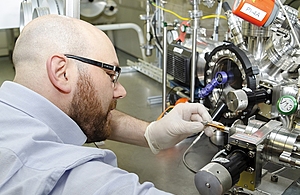Diamonds could be forever in nuclear-powered battery project
UKAEA is partnering with the University of Bristol on world-leading battery technology.

Anthony Hollingsworth researching diamond battery technology at the H3AT facility
Scientists at the UK Atomic Energy Authority are working with academics at the University of Bristol on world-leading technology in order to make diamond batteries, which could provide decades or thousands of years’ worth of energy without a recharge.
Items such as computer chips, smoke alarms, pacemakers, or small satellites could all be operated by such a device.
Tritium scientists at UKAEA’s Hydrogen-3 Advanced Technology facility (H3AT) are at the early stages of establishing a pilot project which could see them eventually become partners in establishing a production line for the diamond batteries.
The battery would be powered by small amounts of graphite from former nuclear reactors – presenting the opportunity to recycle both carbon-14 and tritium into micro-power diamond devices.
Each battery would be very small. Estimates suggest 50kg of carbon-14 would be sufficient for millions of units.
Professor Tom Scott from the University of Bristol initially helped to develop the technology utilising the electrical properties of diamond to produce diamond batteries. The devices operate in a similar way to the photovoltaics used in solar panels (where the conversion of light into electricity occurs) but these devices will harness fast electrons from within the diamond structure rather than using particles of light (photons).
The first small diodes producing power from carbon-14 beta particles have already been demonstrated on a small scale at the University of Bristol.
Scientists at Bristol have been working with UKAEA to trial the placing of deuterium into this diamond structure. Following analysis, they will then attempt the same with tritium.
H3AT tritium engineer Anthony Hollingsworth said: “The fast electrons emitted by the tritium and carbon-14 do not go through the outer layer of the battery. These diamonds are extremely tough – in addition the radioactive part is coated in a non-radioactive diamond layer.”
Professor Scott added: “Bristol are working with Culham to form a spin-out company and set up a pilot run of making these devices. We would look at producing 10,000 or 20,000 devices a year, but ultimately want to be producing millions of devices annually.
“It’s an extremely exciting project – we are aiming to be world leaders in diamond batteries.”